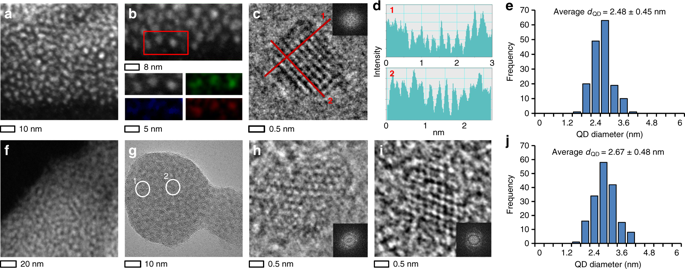Communications Chemistry ( IF 5.9 ) Pub Date : 2019-03-22 , DOI: 10.1038/s42004-019-0138-z
Mitchell T. Clarke , Francesco Narda Viscomi , Thomas W. Chamberlain , Nicole Hondow , Ali M. Adawi , Justin Sturge , Steven C. Erwin , Jean-Sebastien G. Bouillard , Sudarsan Tamang , Graeme J. Stasiuk

|
Indium phosphide based quantum dots have emerged in recent years as alternatives to traditional heavy metal (cadmium, lead) based materials suitable for biomedical application due to their non-toxic nature. The major barrier to this application, is their low photoluminescent quantum yield in aqueous environments (typically < 5%). Here we present a synthetic method for InP/ZnS quantum dots, utilizing a controlled cooling step for equilibration of zinc sulfide across the core, resulting in a photoluminescent quantum yield as high as 85% in organic solvent and 57% in aqueous media. To the best of our knowledge, this is the highest reported for indium phosphide quantum dots. DFT calculations reveal the enhancement in quantum yield is achieved by redistribution of zinc sulfide across the indium phosphide core through thermal diffusion. By eliminating the need for a glove box and relying on Schlenk line techniques, we introduce a widely accessible method for quantum dots with a realistic potential for improved biomedical applications.
中文翻译:

热扩散法合成超亮磷化铟胶体量子点
近年来,基于磷化铟的量子点已经成为传统的基于重金属(镉,铅)的材料的替代品,这些材料由于其无毒的性质而适用于生物医学。该应用的主要障碍是它们在水性环境中的光致发光量子产率低(通常<5%)。在这里,我们提出了一种InP / ZnS量子点的合成方法,该方法利用了受控的冷却步骤来平衡硫化锌在整个磁芯上的平衡,从而在有机溶剂中和有机介质中的光致发光量子产率分别高达85%和57%。据我们所知,这是磷化铟量子点的最高报道。DFT计算表明,通过热扩散使硫化锌在磷化铟核心上重新分布,从而实现了量子产率的提高。

































 京公网安备 11010802027423号
京公网安备 11010802027423号